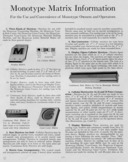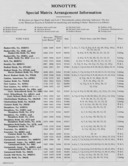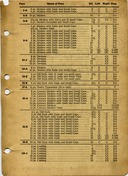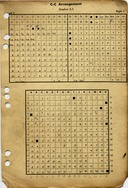
Matrix Information (ca. 1935-1940s)
Monotype Matrix Information: For the Use and Convenience of Monotype Owners and Operators . While this document contains much useful information, it is also quite confusing for a beginner because it refers to machines by several different names. So as a matter of clarification, here are the more common variations on these names along with their equivalents as used in this document:
"Composition Caster" [not used in this document] = "Typesetting Machine".
"Composition-and-Display Caster" = "Composition Caster" + Display Type Attachment.
"Type-&-Rule Caster" = "Display Caster" = "Display Type-Caster" = "Composition Caster" + Display Type Attachment + Strip Attachment - composition abilities.
The names of the "Monotype Material Making Machine," "Junior Monotype Material Making Machine," "Monotype Giant Caster," and "Monotype-Thompson Type-Caster" are used unambiguously. {MTF1}
Click here for the full-resolution version (153 Megabytes).

Special Matrix Arrangement Information
For composition casting. Correlations of Type Face, Keybars, Wedges and Stop Bars, [matrix case] Arrangements, Point Sizes and Set Sizes, and types of Figures. {MTF1}
Click here for the full-resolution version (69 Megabytes).

Face List with Sets, Stopbars, Etc.
This is a list of Lanston Monotype faces, with additional information on set at various sizes, stopbars, etc. It is from some Lanston Monotype publication that I have not yet identified. I found it in the same Monotype operator's binder as the "Matrix Case Arrangements" reproduced below.
The icon at left links to a presentation of this document at The Internet Archive. There you can read it online a page at a time or download it in either the original PDF that I uploaded or a variety of automatically derived formats. Here is a local copy of the PDF (46 Megabytes): monotype-face-list-lst-0600rgbjpg.pdf

Matrix Case Arrangements
This is the bulk of the contents of a binder used by a Monotype operator in a Chicago firm of typographers. It contains matrix case arrangements and keyboard diagrams for Lanston Monotype faces. Some of these are published arrangements, while others are handwritten by the operator. The icon here links to a rather large PDF (249 Megabytes). This binder also contained the "Face List with Sets, Stopbars, Etc." reproduced above.
The icon at left links to a presentation of this document at The Internet Archive. There you can read it online a page at a time or download it in either the original PDF that I uploaded or a variety of automatically derived formats. Here is a local copy of the PDF (249 Megabytes): monotype-case-arrangements-lst-0600rgbjpg50pct.pdf
Cellular matrices employ the following letters to indicate the classification of the face. They appear after the series number, stamped on the series number side of the matrix. Sometimes these are used in references to the face in the literature, sometimes they are not.
| Monotype Matrix Information {MTF1} | {McGrew} | |
| A | Modern Roman | |
| B | Modern Roman small caps | Small Caps |
| C | Modern Italic | Italic Small Caps |
| D | Modern Italic small caps | |
| E | Old Style Roman | |
| F | Old Style Roman small caps | Old Style Small Caps |
| G | Old Style Italic | |
| H | Old Style Italic small caps | Italic Small Caps |
| J | Boldface Roman | Gothic or Bold Roman |
| K | Boldface Italic | Gothic or Bold Italic |
| L | Typewriter, Mailing List, etc. | |
| M | Foreign Faces | |
| S | Swash Characters |
Sources: Monotype Matrix Information {MTF1} . {McGrew}.
Cellular matrices employ the following letters to indicate set sizes. They appear after the point (body) size number, stamped on the point size side of the matrix.
| Z | 5-set |
| Y | 6-set |
| X | 7-set |
| W | 8-set |
| V | 9-set |
| U | 10-set |
| T | 11-set |
| S | 12-set |
| R | 13-set |
| Q | 14-set |
| O | 15-set |
| P | 16-set |
| O | 17-set |
| N | 18-set |
| M | 19-set |
Fractional sets are indicated by suffixing the following:
| a | 1/4 set |
| b | 1/2 set |
| c | 3/4 set |
Sources: Monotype Matrix Information {MTF1} .
Cellular matrices may indicate their unit values using the following lowercase letters. If present, these appear after the series number, stamped on the series number side of the matrix. Note, however, that:
"Alphabetic characters do not have any unit value symbol because their width is fixed by standard arrangement and set-size." Monotype Matrix Information {MTF1}, p. 7 .
"When point-size and set-size are the same, matrices do not have any unit value symbol." Monotype Matrix Information {MTF1}, p. 7 .
Sources: Monotype Matrix Information {MTF1} .
Cellular matrices for fractions employ these symbols. They appear after the point (body) size number, stamped on the point size side of the matrix. (Normally this is where the set size is indicated. Note that these symbols and the set-size symbols (see above) do not overlap.)
| J | Modern figure fractions |
| K | Old Style figure fractions |
Sources: Monotype Matrix Information {MTF1} .
I've got a bit more work to do to understand the encoding of fraction matrices.
Cellular matrices may employ various (alphanumeric) symbols to indicate miscellaneous characteristics.
The following symbols appear after the point (body) size number, stamped on the point size side of the matrix. (Normally this is where the set size is indicated. Note that these symbols and the set-size symbols (see above) do not overlap.)
These are symbols for cellular matrices. Some of them, however, seem to be used when designating display matrix series (e.g. 'H4'); I don't know my Monotype semiotics well enough, yet, to explain this.
Sources: Monotype Matrix Information {MTF1} .
The following symbols appear after the series number, stamped on the series number side of the matrix.
| N | border |
| P | sign |
| Q | logotype (not the ligatures fi, fl, ff, ffi, ffl, which are parts of fonts). |
| R | dash or leader |
| S | bracket, parenthesis, brace, or piece brace |
| T | cross rule |
| X | unclassified character |
| Y | brace |
Sources: Monotype Matrix Information {MTF1} .
Monotype Matrix Information {MTF1}, p. 7 . indicates that "no letters are used in marking display matrices." I have, however, seen letters on matrices; I don't yet know enough to interpret them.
The standard numbers stamped on a display matrix have the following meanings:
| upper left | point (body) size |
| upper right | series number |
| lower left | (special) Normal Wedge 47S |
| lower right | Justification Wedge 46S |
If the lower left number is starred, this indicates that the Abutment-Screw Packing Piece (60S) must also be in place.
Source: The Monotype System, (Philadelphia: Lanston Monotype Machine Company, 1916). pp. 164, 159.
"[English] Display matrices are marked with the face series number and point size of hte type to be cast from them; also with the set measurement in points. Thus, 199-18 towards one end of the matrix means that the face series is No. 199 and the body size is 18 point. At the other end of the same edge of the matrix is a number indicating the 'set' size in points to which type must be cast from the matrix, such as 16 3/4, indicating the sizing wedges must be adjusted to 16 3/4 points."
Source: The 'Monotype' Casting Machine Manual, (London: The National Committee of Monotype Users' Associations In Association with The Monotype Corporation Limited, 1952). pp. 191-192.
"Figures at bottom of Matrix indicate point size and series number; at top, width of body in points on which type should be cast."
Sources: Monotype Matrix Information {MTF1} .
The Lanston "Monotype Matrix Information," "Special Matrix Arrangement Information," pages of "Face Lists with Sets, Stopbars, Etc.," and printed "Matrix Case Arrangements" were published in the US without copyright notice at a time when such notice was required to secure copyright. They therefore passed into the public domain upon initial publication. These digital reprints remain in the public domain.
The annotations and new case arrangements in the "Matrix Case Arrangements" document were unpublished prior to their reprinting here, and therefore were subject to US copyright. However, these were works for hire for the typographic firm employing the operator. I would assert, therefore, that when this now defunct typographic firm sold this information the rights to it passed along with the materials. I am the current owner of these materials, and therefore the current owner of the rights to them. In light of this, I hereby dedicate this information/documentation to the public domain.
All portions of this document not noted otherwise are Copyright © 2010, 2012 by David M. MacMillan and Rollande Krandall.
Circuitous Root is a Registered Trademark of David M. MacMillan and Rollande Krandall.
This work is licensed under the Creative Commons "Attribution - ShareAlike" license. See http://creativecommons.org/licenses/by-sa/3.0/ for its terms.
Presented originally by Circuitous Root®
Select Resolution: 0 [other resolutions temporarily disabled due to lack of disk space]